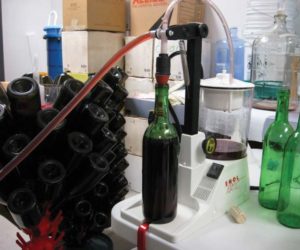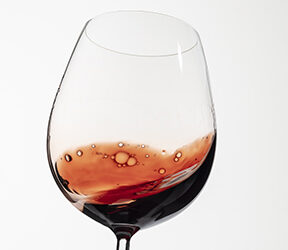
Q
I recently made my first batch of white Zinfandel from a kit. I followed the directions and it’s coming along fine. I bottled and used synthetic corks in the bottles. I let them sit up straight for three days and then tilted them on their sides, like it said. My questions are, do the corks have to go completely in the bottle, and if so, how do you get them there? What causes the bottles to leak even if they seem to be properly corked? I seem to be getting a little bit of wine leaking out of the corks. Is there a way to stop the leaking?
Jeremy Sherman
Sterling Heights, Michigan
A
Synthetic corks are becoming more and more popular as commercial and home winemakers alike seek to avoid the 5 to 15 percent of bottles that can be ruined due to TCA or natural-cork taint. Unfortunately, some synthetic corks actually can leak worse than traditional wine corks. Synthetic corks also can be tough to insert and can form imperfect seals, leading to higher rates of premature oxidation.
The principle of natural and synthetic corks is the same — a plug of compressible material is squeezed down into a tight cylinder, after which it is forced into the neck of the bottle. The re-expansion of the cork, which ideally is perfectly tight and uniformly snug against the bottle neck, causes an elastic-static seal which should keep all wine from getting out and all air from getting in. It is actually a common misconception that wine needs a cork to “breathe” during the aging process. The vast majority of the group of chemical reactions that take place to develop a wine’s “bottle bouquet,” as well as the changed textures we associate with properly aged wine, are reductive reactions that take place in the absence of oxygen. The final “dose” of oxygen a wine needs is received during the bottling process. Any air that sneaks into the bottle after it is corked would cause the wine inside to prematurely oxidize well beyond what is needed for balanced bottle aging.
To answer your first question, no, the cork doesn’t need to be all the way into the bottle in order to form a sufficient protective seal. However, the less of the cork that’s inside the bottle, the greater the chance that the elastic-static seal will become ineffective with time. One hot day in the trunk of the car and it’s likely the cork would come all the way out due to the heat expansion of the liquid inside the bottle. If you want to try to force the corks back into the bottle by hand, then you can certainly try that. Often these corks just won’t go in.
Secondly, corks will leak when the seal created between the cork and the bottle neck isn’t complete and there is a small channel through which wine can escape. Interestingly, glass is chemically classified as a liquid, even though we may think that in real life it’s a pretty solid material. In the glass manufacturing process it’s pretty easy to get bottles that are out-of-round or slightly squashed on one side. In my time I’ve inspected many truckloads of wine bottles from many different manufacturers. I once had to send back an entire truckload because one out of every 10 bottles was so football-shaped it wouldn’t even take the label properly! As you can see, bottlenecks aren’t often the perfect cylinders they seem. Add the fact that synthetic corks often have a harder time than natural corks re-expanding into that imperfect space, and the chance of leakage may be increased.
Is there a way to stop up a leaky bottle? Unfortunately, not really, or not without extracting the cork and re-corking it with a different one.
The closure debate is raging in the wine industry right now, and it really seems to come down to six of one or a half dozen of another — natural corks often have better compression and re-expansion behavior than synthetics, but natural corks can often spoil wine due to the fact that they can’t be sterilized properly. Many wineries are switching to screwcaps, which have none of the above-mentioned problems that corks of any type do. In fact, screwcaps are often considered the perfect wine-bottle closure in technical terms, but a perceived lack of “tradition” or “romance” is keeping many commercial wineries from switching over completely.
Actually, for home winemaking, I think that we should all take a page out of our homebrewing buddies’ book. Why not try crown caps? The greatest Champagne houses in France, when they lay their bottles down for the aging and riddling process, top off their delicate, effervescent and — it certainly can’t be argued — expensive product in Champagne bottles topped not with the familiar mushroom-cap cork but with the same kind of workaday crown cap we pop off a bottle of homebrew. (For more on corks, see the April-May 2003 issue of WineMaker.)

Q
Lallzyme EX is a specially-formulated enzyme that supposedly yields improved color intensity, greater mouthfeel and enhanced fruity, floral and spicy flavors in red wine. Have you ever heard of this? If you have, does it do what it says or is the advertising just a marketing ploy?
Mike Gareau
Fruitvale, British Columbia
Wine Wizard answers: Lallzyme EX is a blend of enzymes that helps break down the plant cells in grapes. This mix of pectinase, cellulase and hemicellulase is introduced at the crusher or right at the outset of fermentation and is most often used for red winemaking. According to the company, this enzyme cocktail aids in the release of tannins, anthocyanins and certain other aromatic compounds during fermentation. Their in-house studies showed an almost 10 percent increase in color intensity in Sangiovese, as well as a 10 percent increase in anthocyanin release, when compared to non-treated control wines. They also claim that the enzyme aids in the release of less-astringent tannins and limits the extraction of “C6 compounds,” a class of compounds of which certain kinds can be responsible for herbaceous character in wine. Adding to the positive press, a formal study presented at the 1999 Joint Burgundy-California-Oregon Winemaking Symposium at UC Davis concluded that Pinot Noir treated with Lallzyme EX exhibited more color on the purple-blue scale — in other words, color that was more intense. It also showed more body and a more spicy, floral and fruity character.
Grape varietals that might particularly benefit from this enzyme are those that often have problems with color stability and extraction: Sangiovese, Pinot Noir and Nebbiolo. If you have the inclination, you might want to conduct side-by-side fermentation experiments in your cellar. Treat two batches identically except for dosing one with Lallzyme EX. The results should indicate what the enzyme does to your favorite style of wine.
For more of the Wine Wizard’s wisdom, check out the latest issue of WineMaker magazine, now available at better home winemaking retail shops and newsstand locations.







